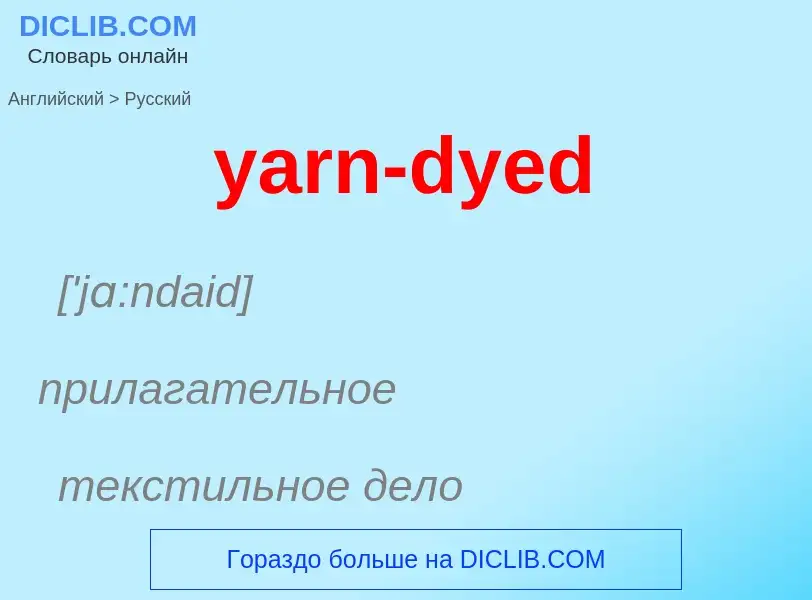Tradução e análise de palavras por inteligência artificial ChatGPT
Nesta página você pode obter uma análise detalhada de uma palavra ou frase, produzida usando a melhor tecnologia de inteligência artificial até o momento:
- como a palavra é usada
- frequência de uso
- é usado com mais frequência na fala oral ou escrita
- opções de tradução de palavras
- exemplos de uso (várias frases com tradução)
- etimologia
yarn-dyed - tradução para russo
['jɑ:ndaid]
прилагательное
текстильное дело
крашенный в пряже
['daiiŋ]
общая лексика
красильный
красящий
крашение
окрашивание
окрашивающий
подкрашивание
существительное
общая лексика
крашение
окраска тканей
красильное дело
крашение, окраска тканей
физика
окрашивание
приобретение цвета
Wikipédia
.jpg?width=120)
Dyeing is the application of dyes or pigments on textile materials such as fibers, yarns, and fabrics with the goal of achieving color with desired color fastness. Dyeing is normally done in a special solution containing dyes and particular chemical material. Dye molecules are fixed to the fiber by absorption, diffusion, or bonding with temperature and time being key controlling factors. The bond between dye molecule and fiber may be strong or weak, depending on the dye used. Dyeing and printing are different applications; in printing, color is applied to a localized area with desired patterns. In dyeing, it is applied to the entire textile.
The primary source of dye, historically, has been nature, with the dyes being extracted from animals or plants. Since the mid-19th century, however, humans have produced artificial dyes to achieve a broader range of colors and to render the dyes more stable to washing and general use. Different classes of dyes are used for different types of fiber and at different stages of the textile production process, from loose fibers through yarn and cloth to complete garments.
Acrylic fibers are dyed with basic dyes, while nylon and protein fibers such as wool and silk are dyed with acid dyes, and polyester yarn is dyed with disperse dyes. Cotton is dyed with a range of dye types, including vat dyes, and modern synthetic reactive and direct dyes.

.jpg?width=200)
![Dyed wool reels ([[CSIRO]]) Dyed wool reels ([[CSIRO]])](https://commons.wikimedia.org/wiki/Special:FilePath/CSIRO ScienceImage 16 Dyed Wool Reels.jpg?width=200)
![Children playing amongst drying colored cloth in [[Bangladesh]] Children playing amongst drying colored cloth in [[Bangladesh]]](https://commons.wikimedia.org/wiki/Special:FilePath/Childhood Joy.jpg?width=200)

![Silk dye in pan on stove. [[Khotan]] Silk dye in pan on stove. [[Khotan]]](https://commons.wikimedia.org/wiki/Special:FilePath/Dye in pan on stove. Khotan, Xinjiang.jpg?width=200)

![Pigments for sale at a market in [[Goa]], India Pigments for sale at a market in [[Goa]], India](https://commons.wikimedia.org/wiki/Special:FilePath/Indian pigments.jpg?width=200)

